
The Effect of The SQ3R Method Using Beelinguapp on Student’s Literal Reading Comprehension
Abstract
Keywords
Full Text:
PDFReferences
Adila, D. N., & Weganofa, R. (2018). The Effect Of Sq3r Strategy On Students’ Reading Comprehension. Jurnal Ilmiah Bahasa dan Sastra, 48-57.
Afinda, B. N., Anwar, S., & Sumarna, O. (2023). Analysis of The Need for Applied Science Teaching Materials in Chemical Materials in Vocational School, Department of Culinary, Tangerang District. Journal of Education and Learning Research, 30-36.
Afzal, N. (2019). A Study on Vocabulary-Learning Problems Encountered by BA English Majors at the University Level of Education. Arab World English Journal (AWEJ) Volume 10. Number 3, 81-98.
Agusti, R. H., Nasir, M., & Islami, N. (2023). Implementation of Contextual Teaching and Learning Based Physics Module on Newton's Law Material to Improve Critical Thinking Skills of Class X Students. Journal of Education and Learning Research, 1(1), 8-19.
Alptekin, C., & Erc¸etin, G. (2010). The role of L1 and L2 working memory in literal and inferential comprehension in L2 Reading. Journal of Research in Reading, 206-219.
Alyousef, H. S. (2006). Teaching Reading Comprehension to ESL/EFL Learners. Journal of Language and Learning, 63-73.
Artis, A. B. (2008). Improving Marketing Students' Reading Comprehension With the SQ3R Method. Journal of Marketing Education Onlinefirst, 1-9.
Aziz, I. N. (2020). Implementation Of SQ3R Method In Improving The Students’ Basic Reading Skill. EDUCATIO : Journal Of Education, Vol 5, 98-106.
Basaraba, D. (2012). Examining the structure of reading comprehension: do literal, inferential, and evaluative comprehensio ntruly exist? Springer Science+Business Media B.V. , 349-379.
Creswell, J. W. (2014). Research Design : qualitative, quantitative, and mixed method approaches. Washington: SAGE Publication Inc.
Hafifah, N. G. (2019). Information and Communication Technology (ICT) in English Language Teaching. Proceedings of MELTC (Muhammadiyah English Language Teaching Conference) (pp. 21-36). Surabaya: Universitas Muhammadiyah Surabaya.
Kartini, A. D., Mayasari, L., & Sofi, Y. (2020). The Effectiveness of Task-Based Learning in Teaching Integrated Skills. Tell : Teaching of English Language and Literature, 8 (2), 58-74.
Khotimah, M. (2017). Using Assessment Of Reading Test Analysis of reading Comprehension Problems towards the Ninth Graders. English Language and Literature International Conference, 134-136.
Klingner, J. K. (2007). Teaching Reading Comprehension to Students with Learning Difficulties. New York: The Guilford Press.
Kusumayanthi, S., & Maulidi, S. M. (2019). The Implementation Of Sq3r Technique In Teaching Reading Comprehension. The Journal of English Language Teaching, Literature, and Applied Linguistics [JELA] ISSN 2656-9094, 74-80.
Meltzer, D. E. (2002). The relationship between mathematics preparation and conceptual learning gain in physics: A possible "hidden variable" in diagnostic pretest scores. American Association of Physics, 1257-1268.
Mohammad, R. A. (2018). The Use of Technology in English Language Learning: A Literature Review. International Journal of Research in English Education.
Nurviyani, V. (2020). Implementation Of Extensive Reading Through A Digital Instructional Media. Eltin Journal Volume 8/No 1, 35-41.
Pandiya. (2013). Rubics on Scoring English Tests for Four Language Skills. Ragam Jurnal Pengembangan Humaniora Vol. 13, 43-49.
Pavlenko, O. O., Bondar, O. Y., Yon, B. G., Kwangoon, C., Tymchenko-Mikhailidi, N. S., & Kassim, D. A. (2019). The enhancement of a foreign language competence: free online resources, mobile apps, and other opportunities. Creative Commons License Attributtion 4.0 Interntional, 279-293.
Ro'ifah, & Hamsia, W. (2022). Need Analysison Lexical Units of Reading Material in an ELT Text-Book. ELS Journal on Interdisciplinary Studies in Humanities Vol. 5 Issue 4, 750-759.
Sari, D. M. (2016). The Use Of Skimming And Scanning Techniques To Improve Reading Comprehension Achievement Of Junior High School Students. Jurnal Edukasi, Volume 2 No.1, 59-68.
Sari, F. P., Hafifah, G. N., & Linda, M. (2020). The Use Of Authentic Material In Teaching Reading Descriptive Text: Review Of Literature. Academic Journal PERSPECTIVE: Language, Education and Literature Vol 8 (, 122-134.
Sari, I. P., Sormin, R. K., Purba, A., Rahayu, A. P., & Khairas, E. E. (2023). Effectiveness of Flash Card Media To Improve Early Childhood English Letter and Vocabulary Recognition in Reading. Journal of Education and Learning Research, 1(1), 1-7.
Satriani, E. (2019). Online Reading Resources among EFL(English Foreign Language) Students: Do They Promote Reading Habit? Journal of English for Academic J-SHMIC, Vol 6, No 1, 8-17.
Sultana, F. (2014). Efficacy of Outside – Classroom English Language Learning: A Study of Intermediate Bengali Medium Students Studying English at Tertiary Level in Bangladesh. International Journal of English Language Education, 29.
Sunga, D., & Yu-Yeh, C. (2012). Perceptions of using online technology in language education: An interview study with Taiwanese university students . Procedia - Social and Behavioral Sciences 51, 405-410.
Thunder, T. (2022, September 16). Reading and Writing. Retrieved from EF BLOG: https://www.ef.co.id/englishfirst/kids/blog/level-comprehensive-reading-dalam-bahasa-inggris-kamu-yang-mana/
Tuan, N. B. (2021). Online Extensive Reading in an EFL Context: Investigating Reading Fluency and Perceptions. Reading in a Foreign Language ISSN 1539-0578.
Universitas Pasundan. (2022, April 8). Apa itu metode membaca SQ3R dan Bagaimana Cara Menerapkannya. Retrieved from Fakultas Teknik UNiversitas Pasundan: https://teknik.unpas.ac.id/blogs/metode-membaca-sq3r-dan-cara-menerapkannya/
WIjayadi, & Mustaji. (2022). The Effect of Community of Inquiry on the Collaborative Skills of English Education Students. International Journal of Social Science And Human Research, 3084-3088.
Woolley, G. (2010). Developing Reading Comprehension Combining Visual and Verbal Cognitive Processes. Journal of Language Literacy, Vol. 33, No. 2, 108-125.
DOI: http://dx.doi.org/10.31258/jes.8.1.p.71-82
Refbacks
- There are currently no refbacks.
Copyright (c) 2024 Rosiana Silfani

This work is licensed under a Creative Commons Attribution 4.0 International License.
Publisher: FKIP Universitas Riau












